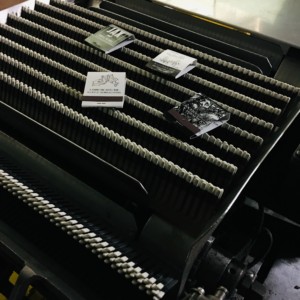There is a difference between Advanced Manufacturing and Traditional Manufacturing. Some companies even think there are different types of “traditional” manufacturing. For our purposes, we agree in calling Advanced Manufacturing those shop floors using robotics and other advanced technologies. But at D.D. Bean where we make the Atlas Matches we disagree with identifying “innovation” as the sole domain of Advanced Manufacturing. In fact, innovation has been driving Traditional Manufacturing since the dawn of the Industrial Revolution. We remember – at least our President, Delcie D. Bean claims to.
Innovation, or what we call “Ingenuity” in our plant, has been and continues to occur daily. Firmly rooted in New Hampshire since 1938, as an American factory we have seen hundreds of creative and talented people walk through the door. Innovation begins with an idea, a perception of a way to make something just a little bit better. It is these iterations – building on a good idea – that can transform any factory into an efficient machine. And we love machines.
The idea of tiny improvements having a big impact over time was not born with James Clear in Atomic Habits. But his book does an amazing job of explaining the concept of improvements and habits, while offering hope to all of us who strive to get better at whatever we are doing. In our manufacturing process of matchbooks, firestarters and box matches, we subscribe to seven steps:
- Identify an issue or opportunity
- Generate some ideas
- Work out a prototype solution on paper or in the machine shop (at least that is where it happens at D.D. Bean / Atlas Match)
- Test the idea
- Implement the idea
- Evaluate the idea
- REPEAT
Seven steps to improvement. The process is applied on our Traditional Manufacturing floor here in Jaffrey, New Hampshire, USA. We apply this process for all improvements and innovations. We apply this process when we want to make something better, faster, safer.
New is not always better. Sometimes used and re-designed is better. What I mean here is that certain materials will always be a part of our Traditional Manufacturing plant. We will always bend and weld metal here. There will always be conveyors to move product, and motors and gears and timing marks. But we are not afraid of change. True, in this USA match plant we don’t change for the sake of change. But we do change. All the time. It is impossible not to change if you are manufacturing anything in America today. We change with intentionality. Remember steps 1-7 listed above.
Today we are faced with new challenges. We are not being out-engineered by Advanced Manufacturing. But there is stiff competition from overseas, competition from a “more convenient light” (the eco-unfriendly lighters) and competition from other advertising mediums. The world is going digital, and our USA produced matchbook might not cut through the clutter.
Like the Simple Minds sang, Don’t You Forget About Me. But we won’t be alone. We hope other US Manufacturers will keep standing alongside us. Like the factories of our suppliers located across America. Our many retail customers in major distribution hubs on the east and west coasts. Those matchbook users and restaurant owners living in the populated US cities.
We will continue to work our craft of matchbook making. The last of our kind. The sole surviving match factory in our United States. And we will continue using Traditional Manufacturing methods, with an emphasis on innovation and continuous improvement. We will implement change and adapt as quickly as we can. And we will employ new technologies, where they make sense. And most of all, we will honor our history and its place in Americana as both an iconic product and a very special industry.


